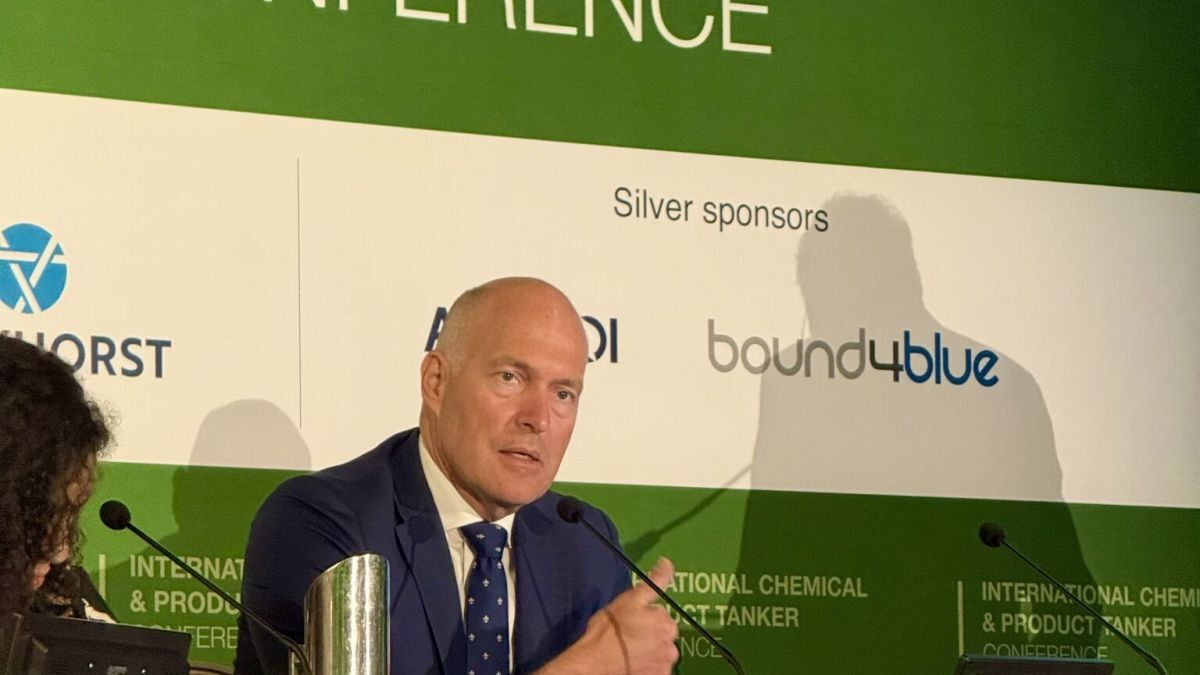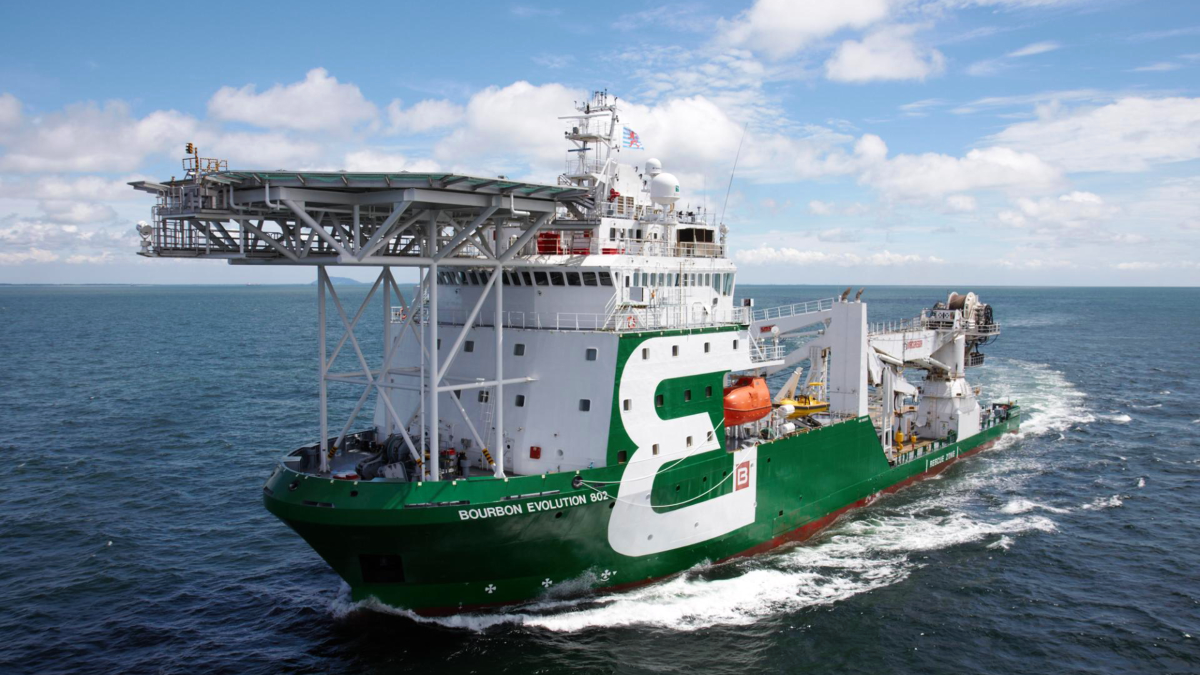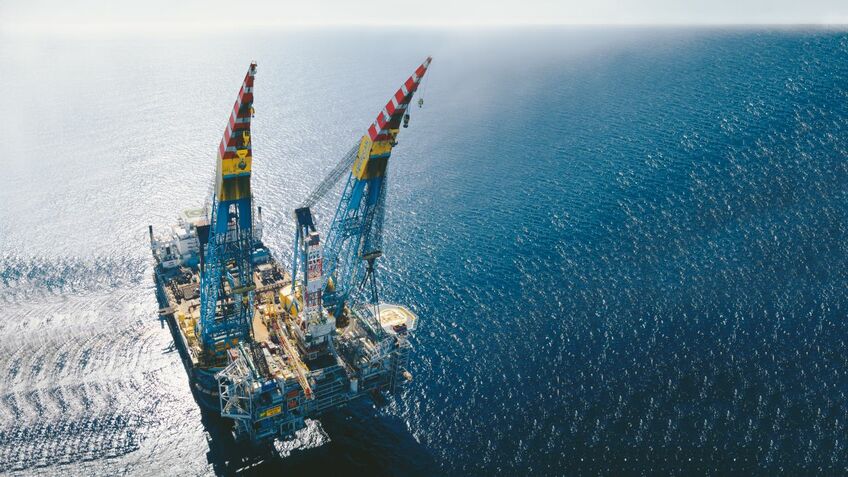Business Sectors
Events
Contents
Flexible IMR vessel can adapt to client needs
Describing the background to Bourbon Offshore’s decision to invest in new subsea/inspection, maintenance and repair vessels (IMRs), Patrick Belenfant, senior vice president business management at Bourbon, explained that the company has been active in the subsea market since 2000, initially deploying ROVs and, from 2004 onwards using crane vessels to install and retrieve subsea infrastructure on behalf of many well-known clients. In 2008, the company acquired DNT, which specialised in the provision of ROV services in the shallow water and deepwater markets.
“We have a total of 19 vessels dedicated to the subsea sector,” Mr Belenfant explained, “plus the remaining Evolution 800 vessels that are on order, and have installed hundreds of Xmas trees and other pieces of equipment such as jumpers, using our crane vessels.”
Subsea surveys and visual inspection work continue to form a large part of what the company does, but with the volume of subsea installation work clearly likely to increase and that work moving further into deep water, the capacity of the crane on the new vessels was obviously a particularly important consideration.
“Apart from a larger, high-capacity crane, when we analysed what we wanted from the new vessels we decided that, apart from a highly reliable work platform, our clients also needed an especially reliable vessel, with a high level of redundancy everywhere. Hence the vessels are DP class 3, with three stern thrusters, three bow thrusters and two enginerooms.
“We also knew that, for flexibility, two cranes would be required, and that both would need to have active heave compensation in order to ensure that we could operate in adverse weather conditions, and ensure that the equipment being lowered by the cranes was protected at critical moments such as when the load approaches the seabed.”
Another important aspect of the vessel was the accommodation, and the provision of meeting rooms for client personnel. “We wanted to be able to accommodate more than 100 people on board in good quality cabins and provide at least two large meeting rooms and plenty of office space,” he explained.
“If a client requested it – for instance, if we are operating alongside a floating production, storage and offloading (FPSO) unit – we also wanted to be able to significantly increase the accommodation capacity up to 240 by adding accommodation modules on the deck.”
Mr Belenfant said Bourbon has already conducted a study on the use of 40ft accommodation modules on the deck of the vessel, plus extra lifeboats and extra livesaving appliances and an extra messroom, should any of the Evolution 800s be required to operate in ‘floatel’ mode.
“Allied to this, we wanted a helideck capable of accommodating an 11-tonne helicopter, and a docking facility for small craft which is designed to interface with the bow of the company’s Surfer-type crewboats. This enables passengers to disembark directly from the crewboat to the vessel and avoids the needs for basket transfer. It also speeds up the crew change process and is a much safer operation.”
The nature of the work that a subsea vessel carries out also means that communications is an essential feature of a ship. Stabilised maritime very small aperture terminals (VSATs) have become a common feature on many types of offshore vessels, with data rates that typically range from 56 kilobits per second (kbps) up to 4 megabits per second (Mbps). They have become a regular part of the fit on many offshore vessels, but as Mr Belenfant explained, given the nature of the work that the vessels carry out on behalf of clients, Bourbon decided to fit not one but two VSATs on the Evolution 800 series.
“Like the overall design of the vessel, the machinery and the DP system, this is another example of where the Evolution 800 series has a very high level of redundancy,” said Mr Belenfant. “It ensures that the ship can always be in contact with our clients ashore, wherever they are in the world and, if there is a problem for any reason with one of the VSATs, we can re-route communications traffic through the other terminal.”
The ability to carry more cargo than some of the other vessels in its fleet was also important, as was a large cargo deck (1,200m2 with a deck loading capacity of 10 tonnes/m2 over the aft deck and 5 tonnes/m2 over the forward deck).
“We also wanted to be able to store plenty of fuel on board the vessel, in order to be able to resupply other units if required,” Mr Belenfant explained, “and we wanted to be able to store a lot of fresh water (940m3) and provide plenty of space for special products – such as methanol, for instance – so that the vessel would have the ability to inject methanol or glycol into a well if we were required to conduct any well stimulation work on behalf of a client.”
The design that became the Bourbon Evolution 800 series is far from being just a subsea/inspection, maintenance and repair vessel, however. Bourbon also wanted the vessels to have a rescue capability for as many as 150 personnel and be capable of deploying oil recovery equipment and of spraying dispersants so they could respond to an offshore oil spill (the vessels will not routinely carry oil spill response equipment such as booms, or a Transrec system, but most charterers have such equipment on standby should it be required).
Back in 2004, another Bourbon vessel, the UT 745 LE Bourbon Opale, was converted into a well test vessel on behalf of Pemex, Mexico’s state-owned oil company. On completion of the conversion, the vessel had capacity for 10,000 barrels of oil and had been fitted with a compact topsides system supplied by Expro.
Bourbon’s experience of converting the vessel into a well test ship has also proved pertinent to the design of the Evolution 800 series, and the company has conducted a study addressing how the design could be modified to carry out this kind of work. This would require the existing cargo facilities to be removed and replaced with tanks for cooled oil, a flare boom and related equipment. The market for this kind of vessel is not large but Bourbon believes it will be well-placed to win any tenders, should they emerge from Pemex or other customers. There are only a few vessels of this type anywhere in the world, and it is unlikely that another owner would embark on a speculative newbuild.
The naval architects tasked with designing a vessel that could carry out such a wide range of tasks was Seattle-based Guido Perla & Associates, with whom Bourbon has a long history of working, on vessels such as the Bourbon Liberty series of anchor handlers and platform supply vessels (PSVs) and the GPA670 series, a type of multipurpose supply vessel, examples of which have also been modified for subsea work.
Bourbon tasked Guido Perla & Associates with responsibility for the concept design, regulatory package and final design of the new vessel, having begun discussing the requirements for the new ships in mid-2007. As George Karantsavelos, a senior naval architect and head of the stability department at the company, explained, the design drew both on technical concepts used in the Bourbon Liberty series and on the highly successful GPA 670 series of multipurpose PSVs, which the company also designed for Bourbon.
Olivier Daniel, who is Bourbon’s newbuilding manager, explained that the Bourbon Liberty concept is based upon economies of scale, reliability and standardisation. He said that these same principles were applied on Bourbon Evolution and that, although only 10 Evolution 800 vessels have been ordered, compared with more than 70 of the Liberty series, ordering the subsea vessels in series had enabled Bourbon to get what he called “very competitive proposals” from its supply chain.
Bourbon originally ordered four GPA 670s, but subsequently expanded the order to a total of 10 vessels, all of which were built at Zhejiang Shipbuilding. The 670s are also diesel-electric vessels, and were equipped with two stern-mounted Kawasaki KST-200 360-degree azimuthing Z-drives driven by variable speed motors. The original GPA 670s were designed to carry bulk cargo and liquid mud in self-cleaning oval tanks; subsequent versions of the design ordered by Bourbon and also built at the Chinese yard were modified to enable them to carry special products, and to work in the subsea market and operate ROVs.
“Some of the GPA 670s were modified to operate ROVs, two of them were also fitted with cranes, and we looked at a range of options for them over the years such as fitting an A-frame or different kinds of structural modifications,” Mr Karantsavelos explained. “So we already had some experience of working with Bourbon on vessels that could work in the subsea market. We also had a lot of experience with them of designing and building diesel-electric vessels like the Liberty series.
“We began looking at a vessel of around 90m in length and a little over 20m breadth with a large crane, but as discussions went and Bourbon refined its requirement we began to incorporate a number of other features that you now see in the Evolution 800 series,” said Mr Karantsavelos. “This included the rescue capability, oil spill response and the ability to modify the vessel to operate as a mini-FPSO or well test vessel, a role which few other subsea/IMR vessels would have been able to fulfil, not having the potential oil storage capacity or sufficient ship service capacity.”
Based on feedback from Bourbon, Guido Perla & Associates also added the option to incorporate a moonpool (which the naval architect has accommodated between frames 80 and 96) and for the vessel to have the option of an eight-point mooring system.
Mr Belenfant explained that incorporating a moonpool will enable the vessels to be fitted with a handling tower and, if required, to conduct wireline intervention work on behalf of Bourbon’s clients (well intervention is an operation carried out on an oil or gas well during, or at the end of its productive life, to modify it or its geometry, provide diagnostics or manage production from the well; wireline refers to a cabling technology used to lower equipment or measurement devices into the well for the purposes of well intervention and reservoir evaluation).
“Bourbon already has experience of conducting this kind of highly specialised work, and of the kind of intensive co-operation with clients that is required to carry it out,” Mr Belenfant explained. “We have gradually developed expertise in this field, notably with Bourbon Emerald offshore Nigeria.
“We first carried out a project of this type three years ago when the ship was employed as a well stimulation vessel, pumping acid into a well at a depth of 1,350m and we have completed several similar projects since.
“On the Evolution 800, depending on client requirements, wireline operations could be performed either over the side of the ship, or through the moonpool. Wireline operations in deepwater also require the use of a lubricator, a lower riser package and an emergency disconnect package, or a dedicated system. Depending on the charter option, a specific wireline tower would be installed, which would also be suitable for coiled tubing.”
An eight-point mooring system requires the use of winches, power packs, wires/ropes, fairleads, anchors and buoys to hold a vessel on a location within defined limits; an eight-point system uses large winches, wires and anchors to keep a large vessel such as a barge, tanker or, in this case a subsea vessel, in position. Guido Perla & Associates responded to this by incorporating spaces for winch rooms in the vessel.
“As time went on, the vessel grew in size and in the number of things it could do and has become a very, very flexible platform that can be adapted to meet many different requirements for Bourbon’s clients if they need it,” Mr Karantsavelos explained. The first vessel in the series, Ungundja, was fitted with tugger winches in order to help meet a requirement of a project for Total; as the remaining vessels enter the market they are also likely to be modified or adapted to meet the specific requirements of Bourbon’s customers.
“All of these requirements really needed a lot of creativity to fulfil them,” said Mr Karantsavelos. “The original 90m design had four gensets as the basis of the diesel-electric propulsion; now we have six, plus an auxiliary. Then we incorporated a 150-person rescue capability, so we needed to satisfy different damage stability criteria – not only did we have to meet the requirements of IMO Resolution A.534(13) – 2.2.2 (the Code of Safety for Special Purpose Ships [Deterministic]); we also had to meet IMO Resolution MSC.266(84) – 2.2.3 (the Code of Safety for Special Purpose Ships [Probabilistic]). In addition, the design also needed to meet all the requirements of a DP3 vessel.
“All in all, there were quite a lot of design issues to take into consideration for such a special kind of vessel – many more than you would have to on a conventional subsea/IMR vessel. Although essentially derived from multipurpose PSV-type vessels, like the GPA 670, we needed to treat the new ships as passenger vessels too.
“Having started out with a 90m vessel, we ended up with one that was somewhat longer over the deck, with a single curvature hull of the type that we specialise in and with which we have had so much success. We know, for instance, that this makes for good seakeeping characteristics and is easy to build, which keeps costs down, although of course Sinopacific has grown in capability as a builder enormously and now builds more complex hullforms too.”
As highlighted above, versatility is a key benefit of the design, which has the ability to adapt to different operational requirements, operate as a well stimulation, rescue or accommodation vessel or provide light intervention services on wells whilst offering modern, high-specification conditions on board.
If required, two ROVs can be operated from the vessel at the same time, and one of the more remarkable features of the vessel is the ability to operate both cranes and both ROVs simultaneously, without any restrictions. “We are very pleased with the job we did on this aspect of the design,” said Mr Karantsavelos.
“To enable the vessel to operate both ROVs and both cranes, at the same time, across their entire operating envelope was no mean feat. We needed to meet BV’s rules for the classification of steel ships Part D, Ch 19, Sec 2.2.2 (Energy) and Sec 2.2.3 (Loss of Lift) and the US Coast Guard’s 46 CFR 173-020 b; Partially Protected, and Exposed Routes for counter-ballasted and non-counter-ballasted vessels.”
Mr Daniel explained that the vessel is equipped with an anti-heeling system in order to compensate for inclining moments due to crane operations, and noted that the dimensions and mass distributions on board were carefully selected in order to obtain a range of metacentric heights (GMs) and natural periods that prevent excessive roll motions and accelerations through the vessel’s operation profile.
For the naval architect the main issue with regard to carriage of special products such as methanol was creating a designated hazardous area within the vessel and meeting hazardous area requirements. A cofferdam has therefore been built-in to enclose the methanol tanks and, to ensure that the requirement for venting could be met, the naval architect came up with an innovative solution in which the venting pipes utilise the pedestal for the main crane.
Given the nature of the operations that the vessel is designed to carry out – and the ship’s ability to deploy two ROVs simultaneously, at the same time that both cranes are working – it was also essential that the arrangement of the bridge provides a good view of activity on the deck.
“A high level of visibility over the deck was essential in order to ensure that operations can be supervised efficiently and safely from bridge,” Mr Daniel explained, noting that they can also be followed from the client/contractor operations room.
The machinery on the new vessels is broadly similar to the approach adopted for the Liberty series of anchor handlers and PSVs, said Mr Karantsavelos, with the same kind of propulsors as the earlier series, with Cummins and EPD in the US once again responsible for supplying the engines and electrical systems. Converteam was selected to supply and integrate the dynamic positioning system (which was supplied by Beier Radio on the Liberty ships). Each vessel has three type SRP1215 rudderpropellers and a retractable type SRP 550 ZSV rudderpropeller, plus two type STT 4 FP transverse thrusters.
The result is a highly manoeuvrable DP3 vessel, with three 1,686kW azimuthing drives, two 843kW tunnel thrusters and an 843kW drop-down azimuthing thruster at the bow. All of the thrusters were delivered by Schottel, the US-based engine-builder having been selected to provide the sextet of 1,235kW generators, a 1,235kW auxiliary generator and a 450kW emergency generator.
The configuration of the environmentally friendly diesel-electric propulsion system, including two engine and two electrical rooms, creates full redundancy in accordance with DP3 standards and, as Guido Perla & Associates points out, this propulsion system also results in reduced maintenance costs and improved stationkeeping. It also significantly increases crew safety. Because of its design and standardisation, claims the naval architect, the Evolution 800 series can compete with more expensive, similar-sized vessels, reducing operating costs by up to 20 per cent compared with larger vessels.
The deck equipment on the 100m vessels includes a 150 tonne at 10m radius main crane which can lower subsea packages to a depth of 3,000m, and a 40 tonne at 9m radius deck crane. Both cranes have built-in swell compensation systems and can cover the entire 1,200m² deck to ensure handling and storage of equipment over the entire area. The Solas-certified IMR vessel also has significant below-deck cargo capacity.
Bourbon Evolution 800 in brief
• Apart from a large deck and high-capacity crane, the new vessels are also equipped with a helideck designed for a Super Puma Helicopter EC225.
• The GPA 696 IMR design is also certified to satisfy IMO ‘deterministic’ and ‘probabilistic’ damage stability requirements.
• If also required, the vessel can carry a maximum deck cargo of 2,080 tonnes.
• The vessel can accommodate 105 people (more in ‘floatel’ or accommodation ship mode with containerised accommodation on deck), and has accommodation arranged over seven decks, including 33 single-person cabins and 36 two-person cabins.
• In what has been called ‘mini floating production, storage & offloading (FPSO) mode’ the vessel can store 24,000 barrels of crude oil.
• In addition to the above mentioned, this especially flexible design is also equipped for fire-fighting (to FiFi class 1 standard) and can act as a standby rescue vessel if required.OSJ
Related to this Story
Women in Maritime Today: Elin Saltkjel says no day working in maritime is dull
Events
Maritime Environmental Protection Webinar Week
Cyber & Vessel Security Webinar Week
The illusion of safety: what we're getting wrong about crews, tech, and fatigue
Responsible Ship Recycling Forum 2025
© 2024 Riviera Maritime Media Ltd.













